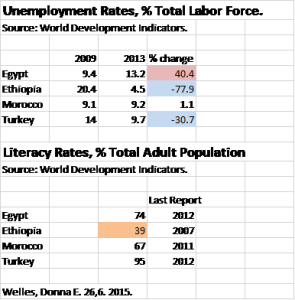By Donna Welles.
Geopolitical analysis of Ethiopia is currently highlighting both the elections that took place this week as well as Ethiopia’s economic growth. Elections there were peaceful, although what has emerged is akin to a one-party system. Allow us to examine Ethiopia’s economic identity using the following indicators, (1) Overall Economic Growth, (2) Bilateral Trading Partners, (3) Unemployment Rates, and (4) Literacy Rates. Although Ethiopia’s population and GDP have grown dramatically in recent decades, Literacy Rates remain a cause for concern.
In terms of both Population and GDP, analysts are correct in that Ethiopia’s economy has grown dramatically relative to other ancient African nations. In 2000, both Egypt and Ethiopia reported a population of 66 million. By 2013, Egypt’s population had grown 24% to 82 million and Ethiopia’s had grown 42% to 94 million. Lower growth in population rates were seen in Morocco and Turkey, 14% and 19% respectively.
Ethiopia’s GDP grew from $8.2billion USD in 2000 to $47.5billion 2013. This is a 476% expansion. During the same time period, Egypt’s economy grew by 172%, Morocco’s by 181%, and Turkey’s by 208%. Ethiopia’s remains the smallest economy of that group, and the only one to double twice.
Bilateral Trade data indicates that the People’s Republic of China is Ethiopia’s largest trading partner, $3.4 billion USD in 2014. The United States traded $1.9 billion in 2014. A second tier of trading partners can be found in the United Kingdom, France, and the Russian Federation. In 2013, the United Kingdom traded with Ethiopia $211 million USD while the Russian Federation traded with Ethiopia $69 million. In 2014, France traded with Ethiopia $189 million USD according to the World Bank.
Since 2009, Unemployment Rates in Ethiopia have improved dramatically. In 2009, 20.4% of Ethiopia’s Total Labor Force was unemployed. In 2013, that number dropped to 4.5%. Unemployment Rates stagnated in Morocco, 9.1% in 2009 and 9.2% in 2013. In Egypt, Unemployment Rates have worsened since 2009 when 9.4% of the Total Labor Force was Unemployed. By 2013, the number was 13.2%.
Literacy Rates in Ethiopia are cause for concern. According to the World Development Indicators Databank, the last time Ethiopia reported Literacy Rates was in 2007 when only 39% of the Total Adult Population could read. Compared to other ancient African nations, Morocco reported in 2011 that 67% of adults there could read, Egypt reported in 2012 that 74% of adults could read, and Turkey reported in 2012 that 95% of adults could read. From the perspective of the New World, 69% of Guatemalans can read whereas 93% of adults can read in Ecuador.



